|
26th anniversary of Central Bus Stand bomb blast :
A nightmare in Pettah
By K.K. Kariyakarawana
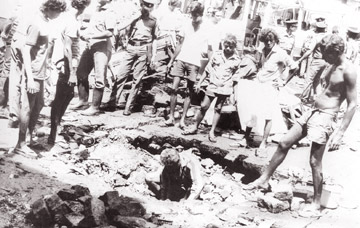
Crater created due to the blast |
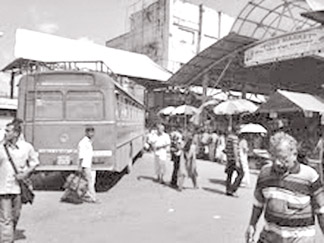 |
The new market
built by the Federation of Self-Employees at the
scene of the blast |
It was around 5.00 p.m. on April 21, 1987: A busy Tuesday evening
after the long holiday of the Sinhala and Tamil New Year. Flocks of
office workers were rushing towards the Central Bus Stand, Pettah to
catch a bus home. Both CTB and private outbound buses were parked along
Bodhiraja Mawatha, loading commuters.
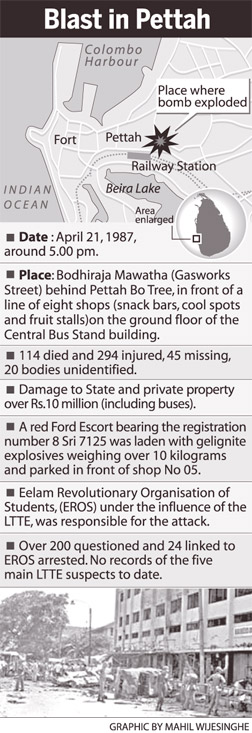 Some people were quenching their thirst with fresh fruit juice while
some were revitalising their energy with a cup of warm tea before the
long journey. Some were bargaining for a basket of apples or grapes to
be bought for their little ones at home. Numerous vendors were crying
out loud to sell their remaining products. Some people were quenching their thirst with fresh fruit juice while
some were revitalising their energy with a cup of warm tea before the
long journey. Some were bargaining for a basket of apples or grapes to
be bought for their little ones at home. Numerous vendors were crying
out loud to sell their remaining products.
The next second, an explosion happened, devastating the entire
vicinity, setting buses and boutiques ablaze. Killing over a hundred and
injuring almost three hundred people, the Central Bus Stand (CBS) bomb
in Pettah entered the country’s gruesome history of terrorist atrocities
over a three-decade period.
Looking back after 26 years, the CBS bomb incident holds an infamous
position among a number of other grisly and large-scale terrorist
attacks as one of the first such serious attacks resulting in a high
number of casualties.
The explosion followed a chain of explosions in 1986, including the
Air Lanka Tristar aircraft bomb on May 3, Central Telegraph Office bomb
in the Fort on May 16, Ceylon Cold Stores warehouse bomb on May 30 and a
bomb planted on the Colombo-bound Batticaloa train in Veyangoda. A total
of 174 deaths was reported in all four explosions whereas over 100
deaths were reported in the CBS blast alone.
Unlike the organised rescue operations we have witnessed in the
aftermath of major incidents reported within the last stages of the
battle against terrorism, there was no proper mechanism to rescue
injured civilians 20 years ago. Hundreds of bystanders voluntarily
rushed to the explosion site and rescued many injured people who were
transferred to accident wards even before the fire engines or ambulances
arrived on the scene. The wounded as well as dying victims were
transported to the hospital in many private vehicles of those who merely
happened to be passing the scene.
The powerful bomb containing 25 kilograms of Gelignite had been
planted inside a secret compartment of a red Ford Escort car that was
parked in front of one of the eight shops on the ground floor of the
Central Bus Stand building.
A six-foot deep crater with a width of eight foot had been created on
the spot where the car was parked. The CID that initiated investigations
under the orders of the then Inspector General of Police Cyril Herath
found that the car had been brought to the scene, pushed by a group of
persons. The driver and his accomplice who had staged a fake breakdown
had sought public assistance to station it in front of the CBS shops.
Soon after, they had disappeared, claiming to search for a mechanic.
The car bomb was found to have been detonated using a remote
controlled device. Additional Government Analyst A.R.L. Wijesekara,
issuing a report following the investigations, said the pattern of the
blast was similar to the four previous explosions in 1986.
The Minister of National Security Lalith Athulathmudali, in an
interview with the BBC said, according to the technical evidence and
statements recorded from the suspects, the Eelam Revolutionary
Organisation of Students (EROS), under the backing of the LTTE had
masterminded the attack in Pettah.
Two hundred individuals were questioned regarding the attack and 24
who were believed to have had direct links with the EROS were arrested
by the police. The CID found that the car used in the explosion formerly
belonged to a resident of Nallur named Miss Selvanayaki. The car was
gifted to her by her brother, a doctor who had returned to the country
in 1980 from the UK. The car had been purchased from England. The car
was later sold to a Panchacharam in Eravur in 1983, who had sold it to a
Meersaibo of Kathankudy in January 1987. Investigations revealed that
Meersaibo had purchased the car with the influence of a group of LTTE
members in Batticaloa identified as Newton, Siddharthan, Gopi, Kannan
and Pottu whose records had not been ascertained to date.
The group had then modified the car in a garage in Kathankudy, with a
secret compartment built within the rear seat and the trunk where the
explosives were hidden.
Weeks after the blast, the government considered a compensation
scheme for the victims. The then Secretary to the Ministry of
Rehabilitation Austin Fernando, in a news report, had said that 340
claims for compensation were received.
Clerk at the Central Bus Stand office, Maurine Shiela Peters
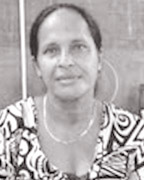 A lucky survivor who had a narrow escape from the blast was Maurine
Sheila Peters, a clerk attached to the office of the Central Bus Stand
in Pettah. A lucky survivor who had a narrow escape from the blast was Maurine
Sheila Peters, a clerk attached to the office of the Central Bus Stand
in Pettah.
Maurine who climbed down the stairs of the four-storey building after
work around 4.30pm decided to buy some fruits from the adjoining line of
vendors on Bodhiraja Mawatha then known as Gasworks Street.
She went to her usual fruit seller, two partners known as Karune and
Sumane, who insisted she buy some fresh guava. However, she changed her
mind and hurried back to Olcott Mawatha to get on a bus to Dematagoda,
her home town. Only minutes after she arrived at Olcott Mawatha, an
explosion virtually penetrated her eardrums.
Large crowds were seen running hither and thither and it took a while
for Maurine to realise that a powerful bomb had exploded on the other
side of the Central Bus Stand where she had stood a few minutes ago.
“I rushed to the scene without any idea, to witness buses and other
vehicles along with a line of small tea and fruit kiosks set ablaze and
clouds of black smoke covering the area. A large number of people had
fallen on the road, here and there, and were lying dead or injured,
faintly crying for help and covered with blood or burnt injuries.
“I could not help running towards my usual fruit seller. To my utter
despair and sorrow, I found Karune and Sumane who offered me fresh
guavas a moment ago lying dead in their own kiosk. It was an
unforgettable sight in my life.
“The road was scattered with pieces of human flesh and debris.
Glasses and burning cars were amidst groups of people rushing to rescue
the injured and clear the debris. Police and firefighters
were engaged in extinguishing the burning vehicles and boutiques”.
According to Maurine, the blast had caused extensive damage to one
side of the CBS building. The ceilings were ripped off, window panes
were shattered and considerable damage caused to the walls.
To their utter horror, they found a half-burnt arm, severed from its
elbow, hanging from the roof of the building when they came to work the
next day.
Former Director, Colombo National Hospital, Dr. Oliver Fernando
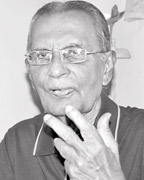 The then Director of the Colombo National Hospital, Dr. Oliver
Fernando, recollecting memories from 26 years ago, said it was the worst
terrorist incident up to that time, where the accident service was
flooded with a large number of casualties and bodies. The then Director of the Colombo National Hospital, Dr. Oliver
Fernando, recollecting memories from 26 years ago, said it was the worst
terrorist incident up to that time, where the accident service was
flooded with a large number of casualties and bodies.
“I was in my bungalow when I received the call around 5.00 in the
evening. I immediately checked with my assistant officer. I soon made my
way to the old accident service building which had already been
receiving a chain of casualties in various conditions. It took only
moments for the corridors to be piled up with bodies. The air was filled
with an unbearable stench of baked flesh and blood.
“Most were injured due to sharpnel and debris of the blast while many
had received severe burnt wounds.
“Action was immediately taken to summon a full staff; over 50 to 60
government and non-government doctors voluntarily took part in the
operations. There were only 70 beds in the accident service at that time
of which 52 were in the male section and 18 in the female section. We
faced a great challenge in finding space for the inflow of casualties as
the old accident service premises which was located near the Norris
Canal had limited space.
“I called the adjoining wards in the National Hospital premises which
was then called the Ragama Section and asked for 20 beds from each of
the 10 wards where we managed to find space for the growing number of
casualties.
“We took measures to remove all the bodies from the accident ward and
lay them outside in the open garages of the doctors due to the lack of
space and more, due to the stench and disturbance they caused for the
urgent operations.
“An initial count gave the figures at over 250 injured and over 100
dead. The triage was conducted and a number of vital surgeries carried
out simultaneously in several theatres while all the others with minor
injuries were also attended to by doctors, matrons, nurses, hospital
attendants and other staff.
“By 3.00 the following morning, we could register and record the
names of all the injured and most of the dead.
“Amidst the operations, the hospital faced a severe shortage of blood
which was however answered by hundreds of voluntary donors from the
public including bhikkhus and Boy Scouts.
“The hospital staff worked continuously for five to six days, day and
night to restore normality and control the situation”. Dr. Fernando, who
is in his eighties now and is retired from an active service, said that
it was one of the most gruesome moments he had experienced in his
long-standing career.
Victim of a lifetime ailment, Shanthi Dias
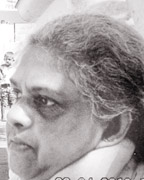 The sudden death of a family member can bring you piercing pain that
can last a lifetime, or it might eventually fade away, leaving traces of
the memory of that loved one. However, to live with distress and agony
for ever because of a lifetime injury to a nearest and dearest takes a
lot of courage. The sudden death of a family member can bring you piercing pain that
can last a lifetime, or it might eventually fade away, leaving traces of
the memory of that loved one. However, to live with distress and agony
for ever because of a lifetime injury to a nearest and dearest takes a
lot of courage.
Sixty one-year-old Shanthi Dias is one such unfortunate victim who
sustained a lifetime injury following the 1987 blast. A former employee
of Associated Newspapers of Ceylon Limited, Shanthi recollected the
series of events which took place on that ill-fated evening.
“As usual, I left Lake House after work and walked up to the Central
Bus Stand to catch my bus to Hanwella. When I was close to the CTB bus
which was parked outside the CBS, I heard a thundering blast from
behind, that knocked me down on the spot. When I was regaining
consciousness, a group of persons was carrying me into the bus that left
the scene immediately. The loaded bus was waiting for a few of its
regular passengers including myself when the explosion occurred.
“Apart from some blood stains on my sari, I had no external injuries
though I felt a pain behind my neck which I believed was caused by the
fall. My husband had come to the Hanwella town to receive me as usual
and after hearing of the incident, he took me to the police station to
lodge an entry. Thereafter, he rushed me to the Jayawardenapura Hospital
where I was treated for a couple of days.
“Since there were no visible injuries or ailments, I decided to
commence work after a month. I was attached to the Classified
Advertising Department where I continued to work for a few more weeks
before I started to feel some strange numbness in my arms and fingers.
It was gradually turning worse and at times, I could not even pick up a
pen.
“After a number of failed attempts to find a cure through Ayurvedic
medicine, I was referred to a specialist doctor who diagnosed that I
have suffered a neurological disorder following the explosion. He
instructed me to take further tests including a Magnetic Resonance
Imaging (MRI) scan. I had to visit India as there were no facilities to
conduct an MRI scan in Sri Lanka at that time. Following the scan, the
Indian doctors told me that a surgery has to be done on my spinal cord,
which has a 50 percent chance of leading to paralysis. The doctors also
asked me to get the approval of my local surgeon Professor Saman
Gunathilaka prior to the operation.
“After many consultations and tests, I underwent the crucial surgery
in 1995 that cost Rs. 350,000. My colleagues at Lake House collected Rs.
100,000 and Rs. 200,000 was donated by the President’s Fund. I felt
normal after the surgery and started working again for another one and a
half years before I started feeling the side-effects of the surgery.
“The second time, doctors diagnosed water inside my brain which had
to be removed by another serious surgery. This process went on till 2007
when I did my last operation.
“I have undergone 13 MRI scans and was subjected to eight risky
operations that cost Rs. 5 million so far, but no significant cure has
been found. I take medicine three times a day which costs me Rs. 10,000
per month. Today, I suffer from constant and severe headaches and face
the risk of passing out at any moment.
My beloved husband looks after me round-the-clock, giving constant
attention in everything I attend to,” said Shanthi, in a desperate
manner, wishing to have her normal life back.
Treasurer, Pitakotuwa Eksath Bodhiraja Samithiya, W.A. Dharmasiri
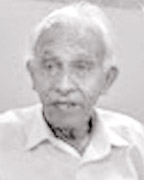 W.A. Dharmasiri is a former shop owner on Bodhiraja Mawatha and the
present Treasurer of the Pitakotuwa Eksath Bodhiraja Samithiya. His shop
was just three shops away from the spot where the explosives-laden car
was parked. W.A. Dharmasiri is a former shop owner on Bodhiraja Mawatha and the
present Treasurer of the Pitakotuwa Eksath Bodhiraja Samithiya. His shop
was just three shops away from the spot where the explosives-laden car
was parked.
Dharmasiri, who was away from his boutique during the explosion, said
that according to eye-witnesses, a group of persons came pushing a car
and parked it in front of Sri Durga Cool Spot which is just three
boutiques away from his kiosk, Sisikelum Cool Spot.
The driver who had claimed a breakdown had abandoned the vehicle to
find a mechanic. It only took a few minutes. The car went up in flames.
“In the blast, the row of boutiques including mine received extensive
damage. The engine of the car was found inside Sri Durga Cool Spot. A
number of pavement vendors and crowds of people returning home after
work were the victims of the blast”, he said. |


